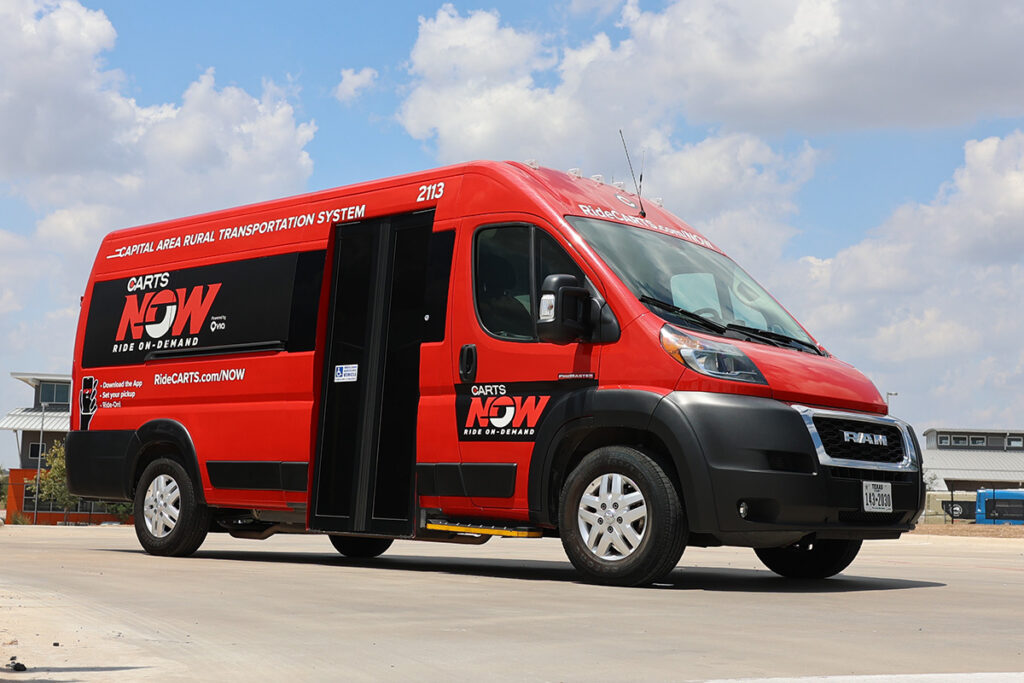Limited access to education, jobs, healthcare, and community resources poses significant challenges in rural regions compared to urban and suburban regions. For example, the USDA Food Access Research Atlas defines low access in urban areas as living within one-half to 1 mile of healthy food sources, while in rural regions, that threshold is 10 to 20 miles. Similarly, an analysis by the Pew Research Center found that rural residents live an average of 10.5 miles from the nearest hospital, compared to 4.4 miles in urban areas, highlighting the disparity in service accessibility. Reliable public transit is crucial to improve access to essential services, employment, and education. The absence of such transit creates financial barriers, often requiring a personal vehicle, which can be a significant expense, further widening economic disparities between urban and rural regions. Microtransit offers a promising solution.
Urban and rural areas exhibit disparities in resource access. As shown in the interactive data visualization, differences between rural and urban counties in the proportion of households without vehicles are less significant than are differences in median household income. This differential shows the importance of prioritizing public transit for rural places to ensure affordable and equitable mobility.
Sources: US Bureau of Transportation Statistics (BTS), Federal Highway Administration, National Household Travel Survey (NHTS), Local Area Transportation Characteristics for Households, 2017; TIP Strategies, Inc.
Note: The map view shown only encompasses the 48 contiguous United States. Column charts showing county distribution of households without vehicle access and of median household income are national and are updated when an individual state is selected. Median household income is a population-weighted average among county census tracts. Urban/rural characterization is based on county census tract categorizations, weighted by population.
Sparse population densities, vast distances, and low walkability pose challenges for implementing fixed-route public transit in rural America. To address this gap between demand and feasibility, microtransit schemes have emerged nationwide from small towns like Montpelier, Vermont, and Smithfield, North Carolina, to suburbs of large cities like Phoenix, Arizona, and Austin, Texas. Microtransit offers on-demand pickup services with flexible routes, providing flat fares within a demarcated region. It differs from traditional demand-response services by optimizing its route to pick up other passengers along the way. Cab aggregators like Uber and Lyft have partnered with cities such as Dallas, Texas, to provide microtransit-like services. Unlike traditional fixed-route systems, microtransit can readily adjust to changes in travel patterns without requiring extensive studies to understand commuting behaviors or costly investments in infrastructure such as bus stops, bus sheds, maintenance facilities, and more.
Critics of microtransit argue that it becomes additively expensive as more people use it, often resulting in heavy subsidies or the adoption of fixed pickup points, resembling traditional fixed-route transit systems. While this may be true, a cost-benefit analysis might overlook other advantages such as enhanced access to resources and opportunities, greater financial flexibility, and improved mental well-being.[1] A 2014 study by the National Center for Transit found that rural transit yielded a benefit-cost ratio of 1.12 nationally (meaning a return of $1.12 for every $1.00 invested), with figures as high as 4.19 in Utah.[2]
Transportation service companies like Via have partnered with rural transportation agencies to extend services into remote areas. For instance, the Capital Area Rural Transportation System has collaborated with Via to offer on-demand microtransit across 7,200 square miles surrounding Austin, Texas. Companies offering a microtransit service bring expertise in route optimization, striking a balance between convenient pickup points, flexibility, and cost. Despite a common perception of rural areas as exceedingly remote, 54.4 percent of rural residents live within a metro area. Microtransit can effectively connect rural areas to the nearest transit hub in urban or suburban areas, bridging the gap between rural and urban transportation networks. This collaborative approach also addresses the challenge of last-mile connectivity, a common issue faced by transit systems worldwide. Such initiatives enhance access to the services and infrastructure available in urban and suburban areas, thereby enhancing the productivity of rural communities and fostering inclusivity within transit systems.
One major challenge to implementing on-demand transit in rural areas is the initial setup cost. The USDOT recently announced $273.9 million in funding for the Rural Surface Transportation Grant Program to support transportation projects in rural communities nationwide. The North Carolina Department of Transportation secured a $10.4 million grant through this program. This funding will aid in establishing microtransit services in 11 communities, inspired by the success of other microtransit services in the state.
With the growing popularity of microtransit across the nation and its promising potential for enhancing public transit ridership post-COVID-19, the future looks promising. Already, autonomous vehicles are operational in microtransit services in Arizona and Michigan, giving us a glimpse of what public transit may evolve into. By leveraging innovations such as electric vehicles, artificial intelligence advanced routing, and satellite internet, and by encouraging collaboration between neighboring rural regions, shared technology and assets can create a robust network capable of fostering an inclusive economy where rural residents gain greater access to services and opportunities.
While microtransit is rapidly expanding across the country, its potential in rural areas remains largely untapped. The full spectrum of challenges and societal impacts that microtransit may encounter or introduce is yet to be fully realized. As this innovative transportation solution continues to evolve, its integration into rural communities will play a pivotal role in shaping the future of public transit in the US.
[1] Reinhard E., Courtin E., van Lenthe F.J., and Avendano M. (May 2018). “Public transport policy, social engagement and mental health in older age: a quasi-experimental evaluation of free bus passes in England.” Journal of Epidemiology and Community Health., Vol. 72, Issue 5, pp. 361-368.
[2] Godavarthy, R. P., Mattson, J., and Ndembe, E. (2015). “Cost-Benefit Analysis of Rural and Small Urban Transit.” Transportation Research Record: Journal of the Transportation Research Board. Vol. 2533, Issue 1, pp. 141-148.
Image credit: Microtransit Cap Area Rural Transit System van (Courtesy of CARTS)



